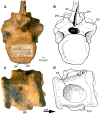Evidence of spondyloarthropathy in the spine of a phytosaur (Reptilia: Archosauriformes) from the Late Triassic of Halberstadt, Germany
- PMID: 24454880
- PMCID: PMC3893247
- DOI: 10.1371/journal.pone.0085511
Evidence of spondyloarthropathy in the spine of a phytosaur (Reptilia: Archosauriformes) from the Late Triassic of Halberstadt, Germany
Abstract
Pathologies in the skeleton of phytosaurs, extinct archosauriform reptiles restricted to the Late Triassic, have only been rarely described. The only known postcranial pathologies of a phytosaur are two pairs of fused vertebrae of "Angistorhinopsis ruetimeyeri" from Halberstadt, Germany, as initially described by the paleontologist Friedrich von Huene. These pathologic vertebrae are redescribed in more detail in this study in the light of modern paleopathologic methods. Four different pathologic observations can be made in the vertebral column of this individual: 1) fusion of two thoracic vertebral bodies by new bone formation within the synovial membrane and articular capsule of the intervertebral joint; 2) fusion and conspicuous antero-posterior shortening of last presacral and first sacral vertebral bodies; 3) destruction and erosion of the anterior articular surface of the last presacral vertebra; and 4) a smooth depression on the ventral surface of the fused last presacral and first sacral vertebral bodies. Observations 1-3 can most plausibly and parsimoniously be attributed to one disease: spondyloarthropathy, an aseptic inflammatory process in which affected vertebrae show typical types of reactive new bone formation and erosion of subchondral bone. The kind of vertebral shortening present in the fused lumbosacral vertebrae suggests that the phytosaur acquired this disease in its early life. Observation 4, the smooth ventral depression in the fused lumbosacral vertebrae, is most probably not connected to the spondyloarthropathy, and can be regarded as a separate abnormality. It remains of uncertain origin, but may be the result of pressure, perhaps caused by a benign mass such as an aneurysm or cyst of unknown type. Reports of spondyloarthropathy in Paleozoic and Mesozoic reptiles are still exceptional, and our report of spondyloarthropathy in fossil material from Halberstadt is the first unequivocal occurrence of this disease in a Triassic tetrapod and in a phytosaur.
Conflict of interest statement
Figures









References
-
- Hungerbühler A (2002) The Late Triassic phytosaur Mystriosuchus westphali, with a revision of the genus. Palaeontology 45: 377–418.
-
- Stocker MR (2012) A new phytosaur (Archosauriformes, Phytosauria) from the Lot’s Wife beds (Sonsela Member) within the Chinle Formation (Upper Triassic) of Petrified Forest National Park, Arizona. J Vert Paleontol 32: 573–586.
-
- McGregor JH (1906) The Phytosauria, with especial reference to Mystriosuchus and Rhytidodon . Mem Am Mus Nat Hist 9: 27–100.
-
- Camp CL (1930) A study of the phytosaurs with description of new material from western North America. Mem Univ Calif 10: 1–174.
-
- Case EC (1932) A perfectly preserved segment of the armor of a phytosaur, with associated vertebrae. Contrib Mus Paleontol Univ Mich 4 (2): 57–80.
Publication types
MeSH terms
LinkOut - more resources
Full Text Sources
Other Literature Sources

